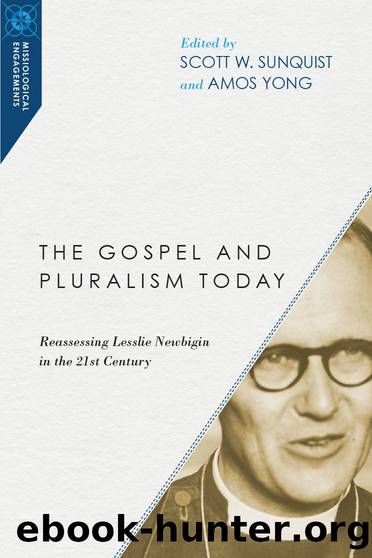The Gospel and Pluralism Today: Reassessing Lesslie Newbigin in the 21st Century (Missiological Engagements) by Scott W. Sunquist

Author:Scott W. Sunquist
Language: eng
Format: azw3
Publisher: InterVarsity Press
Published: 2015-11-05T23:00:00+00:00
The Spirit and Mission Theology: Expanding Newbiginâs Reach
This first section is primarily descriptive, albeit with a hermeneutical twist. Chiefly, I read Newbigin as a trinitarian missiologist and epistemologist, though from a Pentecostal perspective.2 I will then retrieve and foreground the pneumatological threads in his writings largely as they pertain to these themes but also show how they can and ought to be filled out in ways and for reasons consistent with his overall project.
Newbigin as trinitarian missiologist: A Pentecostal and pneumatological perspective. If a theologian like Karl Barth was almost single-handedly responsible for revitalizing the doctrine of the Trinity for Christian theology in the twentieth century, it is not too far-fetched to think that Lesslie Newbigin (1909â1998) played an essential role in retrieving trinitarian theology for theology of mission and mission theology in the wake of Barthâs attainments. Newbiginâs 1963 book, Trinitarian Faith and Todayâs Mission,3 can now, in retrospect, be viewed as a manifesto that opened up conversations between ecumenists, theologians and missiologists across a chasm that had separated those working in the dogmatic disciplines from those laboring in what was considered the more practical fields of ministry and mission. The brilliance of Newbiginâs trinitarian theology of mission derives at least in part from how he understood the historicity of Christian faith in its pentecostal and especially incarnational events as foundational for Christian witness to the gospel in the modern world.4 Thus the proclamation of the gospel revolved around Jesus, âthe one who announces the coming of the reign of God, the one who is acknowledged as the Son of God and is anointed by the Spirit of God.â5 As such, then, Christian mission can be understood no more or less than âas proclaiming the kingdom of the Father, as sharing the life of the Son, and as bearing the witness of the Spirit.â6 Such is manifest as Christian faith, love and hope in action: testifying to the gospel, embodying the gospel in love of neighbor, and living out the gospel in transformative and hopeful action that makes a difference in the world.7
Now while it is more often than not the case that trinitarian theologies are more accurately called binitarian (in terms of their neglect of pneumatology),8 this criticism fortunately applies less to Newbigin. To be sure, Newbiginâs christocentrism is palpable throughout much of his theological output so that one might be tempted to judge that his pneumatology is just as anemic as those found in other putatively trinitarian theological visions.9 Yet this is done only by overlooking the efforts he expended to probe specifically pneumatological matters at significant points over decades of work.10 For our purposes, we can summarize such pneumatological considerations along at least the following three lines.11 First, Newbiginâs pneumatology was part and parcel of his doctrine of God and of Godâs redemptive activity. Thus Christians can only bear witness to the gospel in and through the power of the sovereign Holy Spirit. The mission of God for and through the church, including the churchâs election,
Download
This site does not store any files on its server. We only index and link to content provided by other sites. Please contact the content providers to delete copyright contents if any and email us, we'll remove relevant links or contents immediately.
| Adult Ministry | Children's Ministry |
| Counseling & Recovery | Discipleship |
| Evangelism | Missions & Missionary Work |
| Preaching | Sermons |
| Youth Ministry |
Victory over the Darkness by Neil T. Anderson(2820)
The Rape Of Nanking by Iris Chang(2777)
Chosen by God by R. C. Sproul(2124)
Habits of Grace by David Mathis(1947)
Crash the Chatterbox by Steven Furtick(1942)
Knowing God by J.I. Packer(1807)
How To Be Born Again by Billy Graham(1732)
A Prophet with Honor by William C. Martin(1685)
Gospel-Shaped Marriage by Chad van Dixhoorn(1684)
Peace with God by Billy Graham(1643)
Confronting Christianity by Rebecca McLaughlin(1558)
God's Smuggler by Brother Andrew(1512)
Angel Dreams by Virtue Doreen Virtue Melissa(1448)
Whisper by Mark Batterson(1424)
Missionaries by Norman Lewis(1397)
The School of Biblical Evangelism by Ray Comfort(1393)
The Truth War by John MacArthur(1387)
The Poems of Rowan Williams by Rowan Williams(1324)
Do Greater Things by Robby Dawkins(1295)
